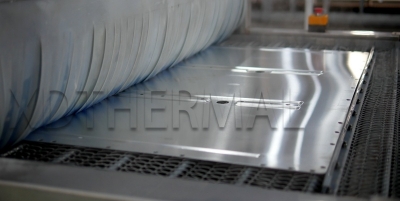La India se enfrenta este año a unas condiciones meteorológicas extremas sin precedentes, que afectan a varios sectores, entre ellos los sistemas de almacenamiento de energía (ESS) y los vehículos eléctricos (VE). Este artículo analiza la urgente necesidad de soluciones eficientes de gestión térmica de baterías, en concreto sistemas de refrigeración líquida, para hacer frente a estos retos.
La India es famosa por sus intensos veranos, que a menudo traen consigo condiciones meteorológicas extremas que afectan significativamente a varios sectores, incluidos los sistemas de almacenamiento de energía (ESS) y los vehículos eléctricos (VE). Las altas temperaturas ambientales plantean un reto crítico para mantener una gestión térmica eficiente de las baterías. Este año, las temperaturas han sido especialmente severas, superando regularmente los 45 °C (113 °F) en muchas regiones.
El calor extremo no sólo afecta a la salud, sino que trastorna la vida cotidiana y las infraestructuras. Las carreteras pueden doblarse bajo el intenso calor, y las vías férreas dilatarse, provocando retrasos y posibles accidentes. Las redes eléctricas se enfrentan a un aumento de la demanda a medida que la gente depende más del aire acondicionado y los sistemas de refrigeración, lo que provoca cortes frecuentes y desconexiones de carga.
Las altas temperaturas también suponen un reto importante para los sistemas de almacenamiento de energía y los vehículos eléctricos, ambos cruciales para el impulso de la India hacia soluciones energéticas sostenibles. Los sistemas de almacenamiento de energía y los vehículos eléctricos dependen en gran medida de las baterías, que son muy sensibles a las fluctuaciones de temperatura. Las altas temperaturas ambientales pueden acelerar la degradación de las celdas de las baterías, reducir su eficiencia y acortar su vida útil. El riesgo de fuga térmica -una situación en la que el aumento de la temperatura provoca una generación incontrolable de calor- aumenta en estas condiciones extremas.
Dadas estas condiciones, se ha intensificado el interés por la refrigeración líquida y los sistemas de gestión térmica de baterías. Estos sistemas ofrecen soluciones eficaces para mantener la temperatura óptima de las baterías en entornos térmicos difíciles. Al utilizar una combinación de refrigeración líquida directa y disipadores de calor de placa fría, estos sistemas garantizan una regulación térmica eficaz, mejorando el rendimiento y la longevidad de las baterías. Esto es especialmente importante para los vehículos eléctricos y las ESS, que son vitales para las soluciones energéticas sostenibles en la India.
La gestión térmica de la batería mantiene las temperaturas de las celdas de la batería dentro de un rango óptimo para garantizar el rendimiento, la seguridad y la longevidad. Una gestión térmica eficaz evita el desbordamiento térmico y mejora la eficiencia general de la batería. Las técnicas incluyen refrigeración por aire, materiales de cambio de fase y refrigeración líquida.
La refrigeración líquida es muy eficaz para controlar la temperatura de las baterías. A diferencia de la refrigeración por aire, la refrigeración líquida utiliza un medio líquido para absorber y disipar el calor con eficacia, por lo que es ideal para entornos de altas temperaturas como la India.
Cómo funciona la refrigeración líquida
La refrigeración líquida consiste en hacer circular un refrigerante, normalmente una mezcla de agua y glicol, por una red de canales o tubos que están en estrecho contacto con las celdas de la batería. Este líquido absorbe el calor generado por las baterías y lo transporta a un radiador o intercambiador de calor, donde el calor se disipa en el ambiente. Este método proporciona una forma más eficaz y coherente de gestionar la temperatura de las baterías que la refrigeración por aire, que depende de la transferencia de calor por convección, menos eficaz.
Ventajas de la refrigeración líquida de baterías
Selección de refrigerante: Elección de refrigerantes eficaces como las mezclas de agua y glicol.
Diseño e integración: Integración de sistemas de refrigeración con baterías para una transferencia de calor eficaz
Seguimiento y control: Utilización de sistemas avanzados para regular el caudal y la temperatura del refrigerante.
Mantenimiento y fiabilidad: Mantenimiento regular para garantizar la integridad y fiabilidad del sistema
La urbanización de la India y su compromiso con el transporte sostenible exigen tecnologías avanzadas de gestión térmica de baterías. Las soluciones de refrigeración líquida afrontan los retos del clima extremo y la creciente demanda de un transporte público fiable.
Iniciativas gubernamentales como el programa FAME promueven la movilidad eléctrica y el transporte sostenible. El fomento de sistemas avanzados de gestión térmica, como los sistemas de refrigeración líquida de baterías y los disipadores de calor de placa fría, refuerza estos esfuerzos y garantiza la seguridad y eficiencia de los vehículos que funcionan con baterías.
XD THERMAL, fabricante líder de placas de refrigeración líquida, suministra componentes de refrigeración de alta calidad para fabricantes de equipos originales de automoción y diversas industrias. Ofrecen servicios integrales de ingeniería, incluidos el diseño, la simulación y las pruebas de validación.

Ventajas de XD THERMAL
La gestión térmica eficaz de las baterías es crucial en un país como la India que se enfrenta a temperaturas extremas. Los sistemas de refrigeración líquida (incluidos los disipadores de calor de placa fría) ofrecen soluciones eficaces para mantener la temperatura óptima de las baterías, garantizando la seguridad, el rendimiento y la longevidad. XD THERMAL se compromete a proporcionar soluciones avanzadas de gestión térmica, combinando tecnología, sostenibilidad y rentabilidad para satisfacer estas necesidades críticas.

He trabajado en la gestión térmica de baterías durante más de 5 años, ocupándome de muchos proyectos internacionales. Si tiene curiosidad sobre los productos o servicios de refrigeración líquida de baterías, ¡no dude en hacerme cualquier pregunta!